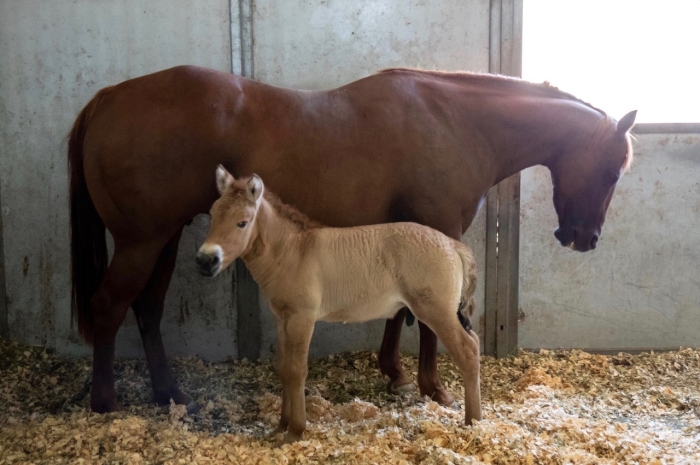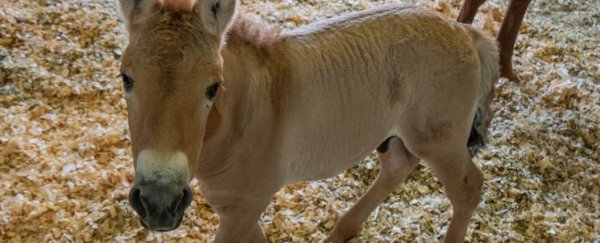A little baby horse named Kurt is a symbol of renewed hope for the survival of his kind. Born on 6 August 2020, he is the world's first ever successfully cloned Przewalski's horse, an endangered wild horse native to the steppes of central Asia.
What makes Kurt even more exciting is that he was cloned from genetic material cryopreserved 40 years ago - reviving genetic diversity thought to have been lost decades ago.
"This colt is expected to be one of the most genetically important individuals of his species," said zoologist Bob Wiese, chief life sciences officer at San Diego Zoo Global.
"We are hopeful that he will bring back genetic variation important for the future of the Przewalski's horse population."

Przewalski's horses (Equus ferus przewalskii) are hanging on by their hooves. The native populations roaming the steppes declined dramatically after World War II, due to a combination of factors such as hunting, competition with livestock as humans moved into their territory, and severe winters.
The last confirmed sighting of a Przewalski's horse in the wild was in 1969.
Luckily, some of the horses still remained in zoos. But not many. A total of 12 horses made up the ancestors of a captive breeding program - 11 Przewalski's horses wild-caught between 1899 and 1902, and another caught in 1947. Thanks to this breeding program, there are around 2,000 individuals today.
That's incredibly impressive, but the growing population isn't without problems.
Those 12 ancestor individuals represent what is known as a population bottleneck - when a species undergoes a severe reduction in numbers. From that point, a population can recover, but it can also be the beginning of the end.
One of the reasons for that is lower genetic diversity. With less variation, a population is less able to adapt to potential stressors or changes to their environment.
Plus, small populations make genetic drift - the random fluctuation of genetic elements in a population - more pronounced. This means that certain traits are more likely to be lost in a population, reducing diversity even further.
On top of all that, small genetically similar populations have a much higher chance of inbreeding, which can cause an inbreeding depression, resulting in unwanted traits spreading through a population and again lowering the likelihood of long-term survival.
Although captive breeding programs did their best, more problems were created for Przewalski's horse. Some interbred the species with domestic horses. Those offspring were controversial, and "pure" Przewalski's horses were split off into a subpopulation that exacerbated genetic drift.
Enter a Przewalski's horse named Kuporovic, who lived from 1975 to 1998. An analysis of the captive breeding pedigree revealed that Kuporovic's genome had unique ancestry from two wild founders.
This meant he offered significantly more genetic variation than any of his living relatives, so in 1980, scientists took a sample and preserved it in San Diego Zoo's Frozen Zoo.
 Kurt and his surrogate mum. (Scott Stine/Revive & Restore)
Kurt and his surrogate mum. (Scott Stine/Revive & Restore)
Kuporovic, of course, did go on to sire offspring the natural way. But Kurt, born over 20 years after his sire's death, is Kuporovic's exact genetic material revived.
San Diego Zoo partnered with wildlife conservation group Revive & Restore and pet cloning company ViaGen Equine to create an embryo using Kuporovic's genetic material.
This embryo was implanted in a domestic horse (Equus ferus caballus) surrogate, and was born healthy after a normal pregnancy. He was named after Frozen Zoo founder Kurt Benirschke.
"This new Przewalski's colt was born fully healthy and reproductively normal," said Shawn Walker, chief science officer at ViaGen Equine. "He is head butting and kicking, when his space is challenged, and he is demanding milk supply from his surrogate mother."
And Kurt represents hope, not just for his own species, but for other endangered species around the world - because he demonstrates the long-term viability of preserved genetic material.
Previously, bulls have been cloned from material frozen 13 years prior. And endangered black-footed ferrets have been bred using sperm that had been frozen for 20 years.
Revive & Restore is also working to bolster the black-footed ferret population; but they also hope that one day they might be able to clone the woolly mammoth. Granted, there's a large difference between 40 years and 4,000 - but it's a small step that makes that goal feel a tiny bit more achievable.
And, in the meantime, Kurt is absolutely worth celebrating.
"After the foal is weaned he will join others of his species at the San Diego Zoo Safari Park," wrote Revive & Restore on its Przewalski's horse project page.
"It is our hope that in five to 10 years, as Kurt matures into the world's first cloned Przewalski's stallion, he will successfully mate and thus contribute to the genetic diversity of his species and to the future of conservation innovation."
